 |
| Spey
Fishing... |
|
It's
9 o'clock in the morning and your standing knee deep in icy
water as cold, hard rain drives into your face. You have been
swinging Flys since dawn. You are thinking "Maybe they're
right, maybe I am completely insane?" And then something happens.
The rod twitches in your hand, adrenaline surges through your
body and you know that you're not. There is this reassuring
whir as the reel screams out line. The rod pounds and bucks,
you grip tighter. A feeling washes over you, so intense that
it is almost as though it's you that's trying to escape, not
them. Nothing matters now. Not the cold. Not the river. Not
the rain. Everything dissolves around you until there is only
one thing left. Pure willpower. The question is: Who has the
most? You or the 20lb Steelhead that's tugging at the end
of your line. These web pages are for the anglers who - even
for the briefest of moments - have understood what it is to
feel like this.
|
|
| You
Know Your A DieHard Spey Fisher If |
- You
shift your truck with both hands.
-
You've spend six hours perfecting a Fly.
-
If you've ever gone swimming to get it back.
- Your
motto is " Go Big or Go Home."
- You
refer to your rod as " Lumber."
- Size
does matter.
|
|
Spey
Fishing
Big Lines - Big Water - Big Fish
Go Big or Go Home!
| Spey
History |
|
A
long time ago, some smart Scottish people living on the river
“Spey,” found they could cast farther, easier and catch more
Atlantic Salmon using both hands.
End of the History Lesson!
Today:
Spey fishing is world wide, and rapidly gaining a huge following
in North America, especially here on the West Coast where
the Steelhead run wild.
Take
a cold, deep river, swollen wide by rain and snowmelt, and
you have the perfect combination for unloading the big gun.
Starting at the top of oversized runs, long rodding veterans
will often attribute their abnormal success to that extra
50 feet of casted line. Especially used water (already fished),
or runs where there is zero back cast room. Imagine waking
up at 8:00 am and still fishing as much fresh water as the
single handers, who got up at 3:00 am! When 98% of fly tossers
are incapable of throwing more than 50 feet, without a dozen
false casts, it is easy to see how a hundred foot cast gives
you an extra 50 feet of fresh water on every cast, every run,
and at any time of the day.
A
Spey cast is essentially a roll-cast. A Spey rod is just a
very long and limber fly rod. The combination of long rod
+ roll cast allows you to fish where many others are unable,
like in front of cliffs, brush and other areas where break
casts are impossible. The long rod also enables awesome line
control, especially in tricky currents and long swings. A
simple flip can mend a ton of line under any conditions.
Still
not convinced that Spey action is the way to go? Well let
me not forget the casting possibilities, the most enjoyable
aspect of a Spey fisherman’s day. You can fish all day without
a take and still have a great time laying the long line cast
after cast. It is the rhythm of step & swing that most anglers
fall in love with long before their first fish. One would
think that levering 15 feet of rod would wear a guy out after
a long day of casting, but in reality the contrary is true.
The rod is so long, that any movement you make is magnified
through the rod.
Think, if you move the rod one foot at your hand, the
rod tip will move 15-20 feet. Compare this with a single hand
fisherman, who has to move his rod 2-3 feet (impossible) to
reach the same casting stroke. Add in the work of stripping
and hauling with the other hand and it is infinitely less
fatiguing to lift lumber.
Hook’em Hard & Turn’em Loose
Ex-Stream Guides
fishing@ex-stream.com
|
|
| How
To Cast A Spey Rod |
- Start
by splaying out as much line as you need to cast. Strip
the line off the reel and shake it out the tip of your rod
in front of you.
-
With your downstream hand on top of the rod lift the rod
till it points slightly behind you. When the line sags to
a D shape, push with the top hand and pull with the bottom
to roll cast your line out. Single Spey Cast
-
Imagine you are standing in front of a clock with the river
flowing from 3:00 9:00. At the end of your swing the line
& rod will be at 9:00. Raise your rod to 11:00, lifting
your sink tip near the surface ( for a floating line take
most of the line off the water ).
-
Flip your line above where you want to cast (ie. If you
want to cast straight out, land your fly 3 to 4 feet upstream)
Note: Accurate placement of your fly on this first flip
is the key to a successful cast. This will move your rod
from 11:00 to 2:00.
-
Swing your rod from 2:00 to 12:00, keeping your rod tip
level so your rod is pointing behind you.
- Now
roll cast as in 2
#2 Double Spey Cast
- Complete
steps #1 through to #3
-
Flip your line upstream, landing the head (floating or sinking)
directly in line with where you want to cast. This will
move your rod from 11:00 to 2:00.
-
Instead of casting, roll your line from 2:00 to ten, keeping
your rod tip level (at the same height) and in a “D” shape
in front of you. During this roll you should hear your line
rip the water to load your rod.
-
Pause ever so slightly, with the tip at 10:00 before continuing
the swing. Still keep the rod tip level to 12:00, so that
the tip is pointing behind you.
-
Roll cast as in step #2 your line should already be sagged
into a “D” shape so go ahead, push & pull.
|
|
| Quick
tips for managing the Spey |
-
When making any line movement, be it the final cast or setting
your line up in a single or double Spey, use your hands
and not your body. Push & Pull - pretty much swing it up.
On your final cast push with your top hand and pull with
your bottom hand, let the rest of your body relax and enjoy
the swing.
-
To make a double Spey, the important tip for loading your
rod is getting the rip. You should hear your line rip the
water as you swing your line around for the final cast.
See step #9 of the Double Spey Cast.
-
When fishing a downstream swing, hold a 1 to 2 feet loop
of line, so that when a fish takes directly below you, you
are able to drop the loop and lift the rod to avoid breaking
off with a tight line.
-
In a fast current, follow your swinging line with your rod
tip to slow the swing down.
-
In a slow current, lead your line through the swing to speed
up the fly.
-
Don’t overlook the Spey for dead drifting or nymph fishing.
You can lower nearly 30 feet with only your rod tip. With
20 feet of line out and a short heavy head, you can cover
a lot of water in a short time. This can be achieved by
having it up-stream, following your line through the drift,
and when the current lifts your fly at the end of the pocket,
just lift it out and lay it back up at the top again. Quick
and effective!
|
|
|
eX-stream MENU  |
|
|
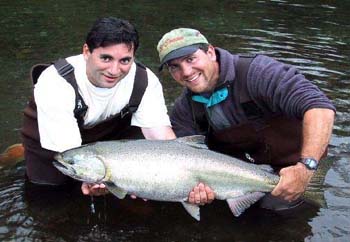
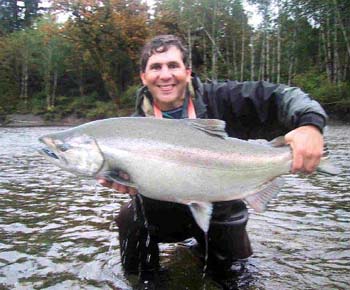
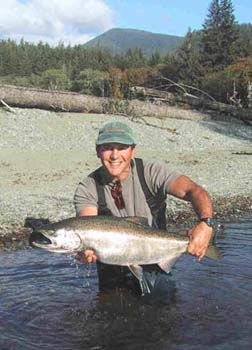
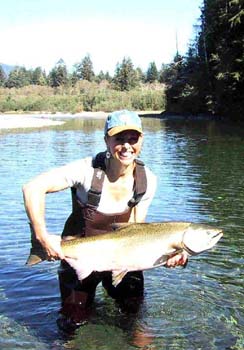
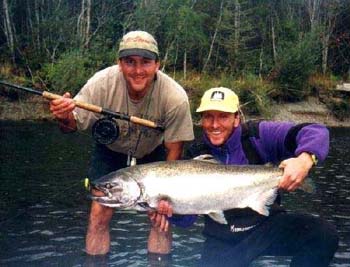
|






